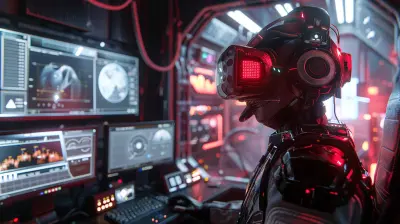The Role of Mods and Custom Content in YouTube Gaming
26 August 2025
Let's be real—YouTube gaming content would not be what it is today without mods and custom content. Whether you're watching someone turn Minecraft into a horror film or add lightsabers to Skyrim, mods have transformed how we experience games, and more importantly, how we watch them.
YouTube has become the go-to portal for gaming culture, and mods are now one of its most powerful engines. But how exactly did we get here? What makes mods so appealing for creators and viewers alike?
Grab your controller (or keyboard), and let's break it all down.
What Exactly Are Mods and Custom Content?
Before we dive too deep, let’s get the basics out of the way.Mods, short for modifications, are changes or additions made to a video game by users or fans. These can be as small as a new weapon or as large as a full game overhaul. Custom content is similar but often refers to aesthetic or gameplay additions—think of new outfits, maps, skins, or characters.
Imagine buying a LEGO set… and then deciding to build a spaceship instead of the castle on the box. That’s modding in a nutshell.
The YouTube Boom: Why Mods Matter to Content Creators
So, why are YouTubers practically obsessed with mods?1. Infinite Content Possibilities
When you play a game normally, there’s a limit to what you can do. But with mods? The sky’s the limit (or maybe not even the sky—space is fair game too). For creators, this means unlimited video ideas.Think about it:
- Minecraft with Pokémon? Yup.
- GTA V with Marvel superheroes? Absolutely.
- Sims 4 families living in haunted houses with vampires and aliens? You bet.
This non-stop flow of fresh content helps creators stay relevant and avoid burnout from playing the same vanilla version over and over.
2. Enhanced Viewer Engagement
Viewers aren’t just watching a game; they’re seeing it reimagined. Mods create curiosity. They invite viewers to say:> “Wait, what version of Skyrim is this?”
That sense of discovery keeps people watching longer and clicking more videos. And for YouTubers, longer watch time equals algorithm love.
3. Niche Communities and Viral Potential
Mod videos can go super niche—modded Among Us killers, zombie-mode Terraria, etc.—and create tight-knit fan bases.Some mods are so bizarre or funny that they go viral. Remember when Thomas the Tank Engine replaced dragons in Skyrim? That one mod alone generated thousands of remixes, memes, and reaction videos.
The Evolution of Mods on YouTube
Let’s take a trip down memory lane.In YouTube’s early days, modded content was more of a novelty. Few players knew how to install mods, and even fewer creators bothered to show them off. Fast forward to now, and entire channels dedicate themselves to mod showcases, tutorials, and let's plays.
Mods have also blurred the line between indie devs and gamers. Some mod teams are so talented their work rivals official game studios.
Examples?
- Counter-Strike started as a mod of Half-Life.
- Dota 2 came from a Warcraft III custom map.
- The Stanley Parable began as a Half-Life 2 mod.
YouTube helped give these mods visibility, which in turn inspired more players to tinker, create, and upload.
Top Games That Shine with Mods on YouTube
Not all games are mod-friendly, but the ones that are? They dominate YouTube. Here are a few fan favorites:1. Minecraft 🧱
This game is practically built for mods. Creators love turning Minecraft into anything from Jurassic Park to a full-scale RPG.Popular modpack series like “RLCraft” or “SkyFactory” draw millions of views and offer a fresh challenge with every episode.
2. The Sims Series 🏡
If Minecraft is the sandbox, The Sims is the dollhouse. Players mod fashion lines, career paths, house builds, and more.Creators often run themed series, like 100 Baby Challenges or occult households, powered entirely by custom content.
3. Skyrim and Fallout 🔮💣
Bethesda games are basically modding playgrounds. You’ve got texture packs, storyline extensions, weapon packs, and more.Plus, they’re funny. You haven’t lived until you’ve seen a Skyrim guard get roasted by Macho Man Randy Savage in dragon form.
4. GTA V 🚓
GTA V’s modding community is massive. From realistic police roleplay to flying cars, modded GTA content has its own subgenre on YouTube.Some creators even turn it into a filmmaking tool, crafting dramatic or hilarious roleplay series with deep narratives.
Mods as Storytelling Tools
Here’s where things get interesting. Mods aren’t just for laughs or eye-candy—they’re powerful tools for storytelling.Creators use mods to craft:
1. Machinimas – In-game cinematic stories.
2. Alternate Universes – What-if scenarios like “What if zombies took over San Andreas?”
3. Roleplays – Entire sagas with character arcs, settings, and plots.
This isn't just playing a game. It’s interactive filmmaking. And for YouTube, where storytelling and personality matter just as much as gameplay, that opens a whole new realm of possibility.
How Mods Keep Older Games Alive
Remember when everyone stopped talking about Skyrim… until someone added Naruto jutsu?One of the coolest things about mods is that they extend a game's lifespan. Games that are a decade old still have active YouTube communities because of custom content.
Mods breathe new life into titles through:
- Remastered graphics
- Fan-made expansions
- Meme-worthy add-ons
- VR or multiplayer conversions
Gamers keep playing, and content creators keep creating. It’s a win-win.
The Challenges (Because It’s Not All Rainbows)
Okay, so mods are great—but they’re not perfect.1. Technical Headaches
Modding isn’t always plug-and-play. Creators often deal with crashes, compatibility issues, and never-ending load orders.Ever tried installing 50 mods in Fallout 4? You’ll need a degree in Computer Science and a bit of black magic.
2. Copyright Grey Areas
Some mods use trademarked IPs—imagine putting SpongeBob in Resident Evil—and though funny, they can legally get murky.YouTube videos using those mods can get demonetized or taken down, which is risky business for full-time creators.
3. Gatekeeping & Toxic Communities
Some modding communities can be intimidating or unwelcoming to newbies. That affects content discoverability and discourages fresh talent from experimenting or sharing.Platforms That Support Modded Content
If you're a YouTuber thinking about jumping into modded content, you're in luck. Most major platforms make it easier than ever.- CurseForge and NexusMods offer thousands of user-generated mods.
- Steam Workshop provides safe, easy one-click modding for supported games.
- Patreon allows modders to monetize their work, leading to consistent updates and quality improvements.
Using these platforms, creators often collaborate with modders, giving shoutouts or partnering on exclusive content. It’s a beautiful synergy of community and creativity.
Monetization & The Business of Mods on YouTube
Let’s talk numbers.Modded content often comes with higher viewer retention and engagement. That means:
- More AdSense revenue.
- Increased sponsorships.
- Higher merch sales thanks to fan-favorite characters or series.
Some creators even review or beta-test mods, getting early access in return for promotions. This has practically created a new micro-economy in the gaming world.
The line between creator and developer is fading. YouTubers aren't just playing—they're influencing how games evolve, and that’s wild.
The Future of Modded Content in Gaming Culture
With AI-generated textures, procedural modding tools, and ever-improving hardware, modding is only becoming more accessible and powerful.In fact, the gaming industry is starting to embrace it:
- Bethesda’s Creation Club lets players use curated mods safely.
- Minecraft Marketplace brings custom content to consoles.
- Roblox is basically one huge modding ecosystem.
And let’s not forget VR—mods are turning flat-screen games into fully immersive experiences. That’s next-level YouTube content just waiting to happen.
Final Thoughts
Mods and custom content have taken YouTube gaming from a simple “watch me play” vibe to a full-blown creative revolution. They break boundaries, spark imagination, and build communities.Whether you're a viewer, gamer, or aspiring content creator, the world of mods is where freedom meets fun. So next time you see a banana-shaped gun in Call of Duty or Pikachu as your Skyrim companion—you’ll know there’s a modder (and likely a YouTuber) behind that madness, making your entertainment a little weirder, and a lot more fun.
all images in this post were generated using AI tools
Category:
Youtube GamingAuthor:

Lucy Ross
Discussion
rate this article
1 comments
Zariah McGlynn
Mods: because who doesn’t want to turn their medieval knight into a dancing llama? YouTube gaming just got fabulously weird!
September 2, 2025 at 3:46 AM

Lucy Ross
Absolutely! Mods bring creativity and fun to gaming, allowing players to explore unique and imaginative experiences, like transforming knights into dancing llamas. It's all about pushing boundaries and enhancing entertainment!


